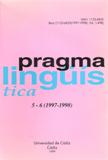The translation of modifying participles in scientific discourse from the perspective of relevance theory

DOI
https://doi.org/10.25267/Pragmalinguistica.1997.i5.13Información
Resumen
Este artículo presenta un ejemplo de la aplicación de la teoría de la Relevancia a la traducción, y muestra que el modelo de comunicación ostensivo-inferencial proporciona una respuesta a la cuestión de equivalencia en traduccI6n. Hemos usado la teoría de la relevancia para determinar si las diferentes formas ligústicas usadas en español para traducir los principios con función de modificadores que aparecen en textos científicos ingleses son apropiadas. La diferencia en los sistemas del participio en ambas lenguas y el hecho de que los principios tienen funciones retóricas especiales en el discurso científico hacen que no exista una forma correspondiente disponible para traducir tos participios ingleses a español.
Palabras clave
Descargas
Cómo citar
Licencia
Derechos de autor 2018 Pragmalingüística

Esta obra está bajo una licencia internacional Creative Commons Atribución-NoComercial-CompartirIgual 4.0.
Citas
BELL, R.T. (1991), Translation and Translating: Theory and Practice, Longman Group UK Limited.
BLAKEMORE, D. (1987), "Linguistic constraints on pragmatic interpretation: on reassessment of linguistic semantics", Behavioural and Brain Sciences 10, 712-713.
EGGINS, S., P. WIGNELL, and J.R. MARTIN (1987), "The discourse of geography: ordering and explaining the experiential world", Working Papers in Linguistics, 5, 25-60.
FRANCIS, G. (1986), Anaphoric Nouns, Discourse Analysis Monographs II. English Language Research. University of Birmingham.
GUTT, E. A. (1991). Translation and Relevance. Cognition and Context, Oxford, Blackwell.
HALLIDAY, M. Α. Κ. (1985a), An Introduction to Functional Grammar, Edward Arnold.
HALLIDAY, M. A. K. (1985b), Spoken and Written Discourse, Oxford, O.U.P.
HANANIA, E.A.S. and K. ΑΚΗTAR (1985), "Verb form and rhetorical function in science writing: A study of M.S. theses in biology, chemistry and physics", The ESP Journal, 4, 49-58.
LACKSTROM, J. E., L. SELINKER and L. TRIMBLE (1972), "Technical rhetorical principles", Papers of the 3rd A.I.L.A. Congress.
LACKSTROM, J. E., L. SELINKER and L. TRIMBLE (1970), "Grammar and technical English", en Lugton, R.C. (ed.), English as a Second Language: Current Issues, Philadelphia. Center for Curriculum Development.
MALCOLM, L. (1987), "What rules govern tense usage in scientific articles?", ESP 6, 31-44
QUIRK, R., S. GREENBAUM, G. LEECH, and J. SVARTVIK (1985), A Comprehensive Grammar of the English Language, London, Longman.
REAL ACADEMICA ESPAÑOLA. (1975), Nueva Gramática de la Lengua Española, Madrid. Espasa Calne, S.A
SINCLAIR, J. M. et AL. (eds.) (1987), Cobuild: The Collins Cobuild English Language Dictionary, Collins.
SPERBER, D. and D. WILSON (1986), Relevance: Communication and Cognition, Oxford, Blackwell.
SPERBER, D. and D. WILSON (1987), "Precis of relevance: communication and cognition", Behavioural and Brain Sciences, 10, 697-754.
SWALES, J. (1974), "Notes on the function of attributive en participles in scientific discourse", Papers in English for Special Purposes. N° 1, University of Karthoum.
TRIMBLE, L. (1985), English for Science and Technology. A Discourse Approach, Cambridge, Cambridge University Press.
WILSON, D. and D. SPERBER (1988), "Representation and Relevance", en Kempson, R.M. (ed.), Mental Representations: the Interface between Language and Reality, Cambridge University Press, Cambridge, 133-53.






